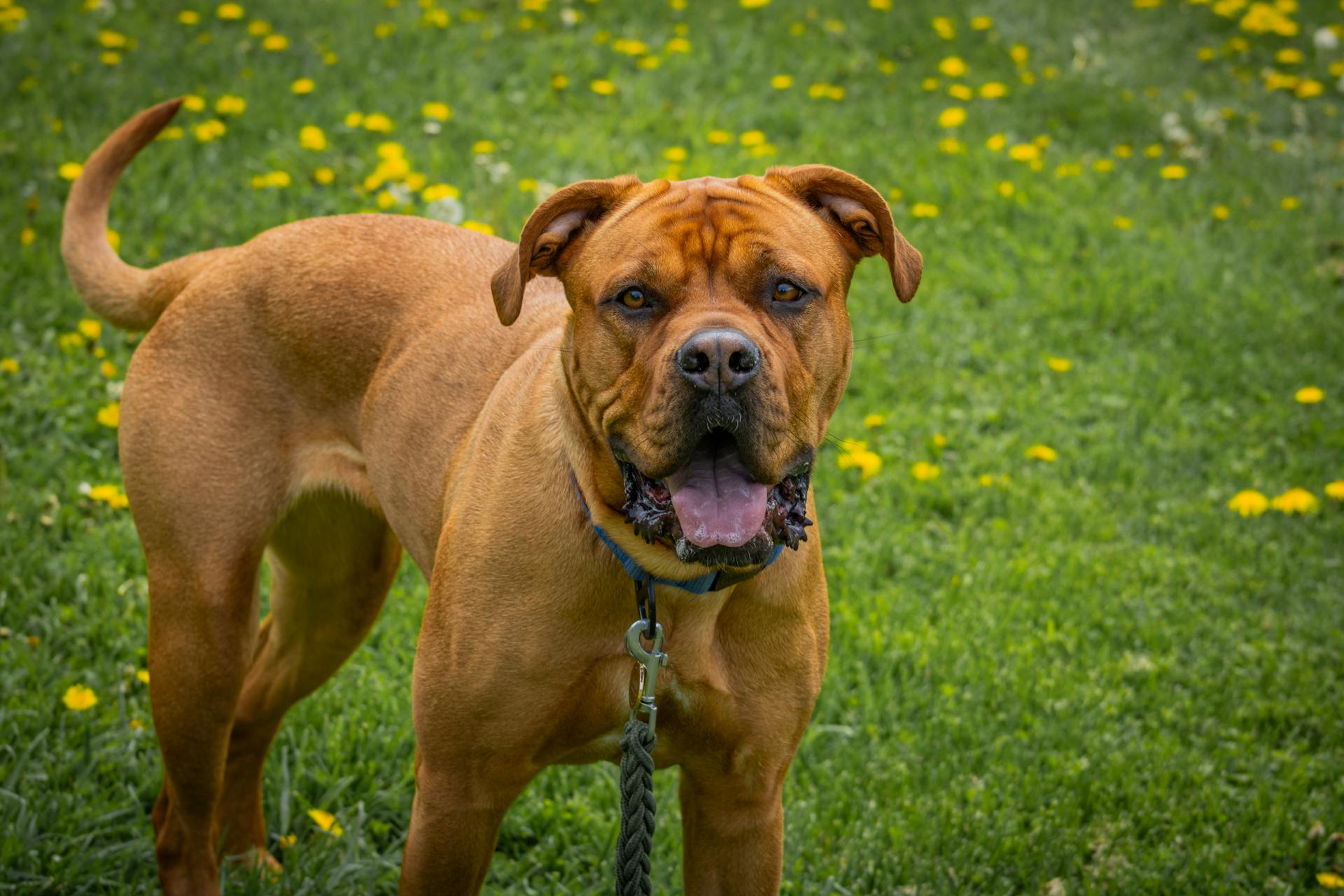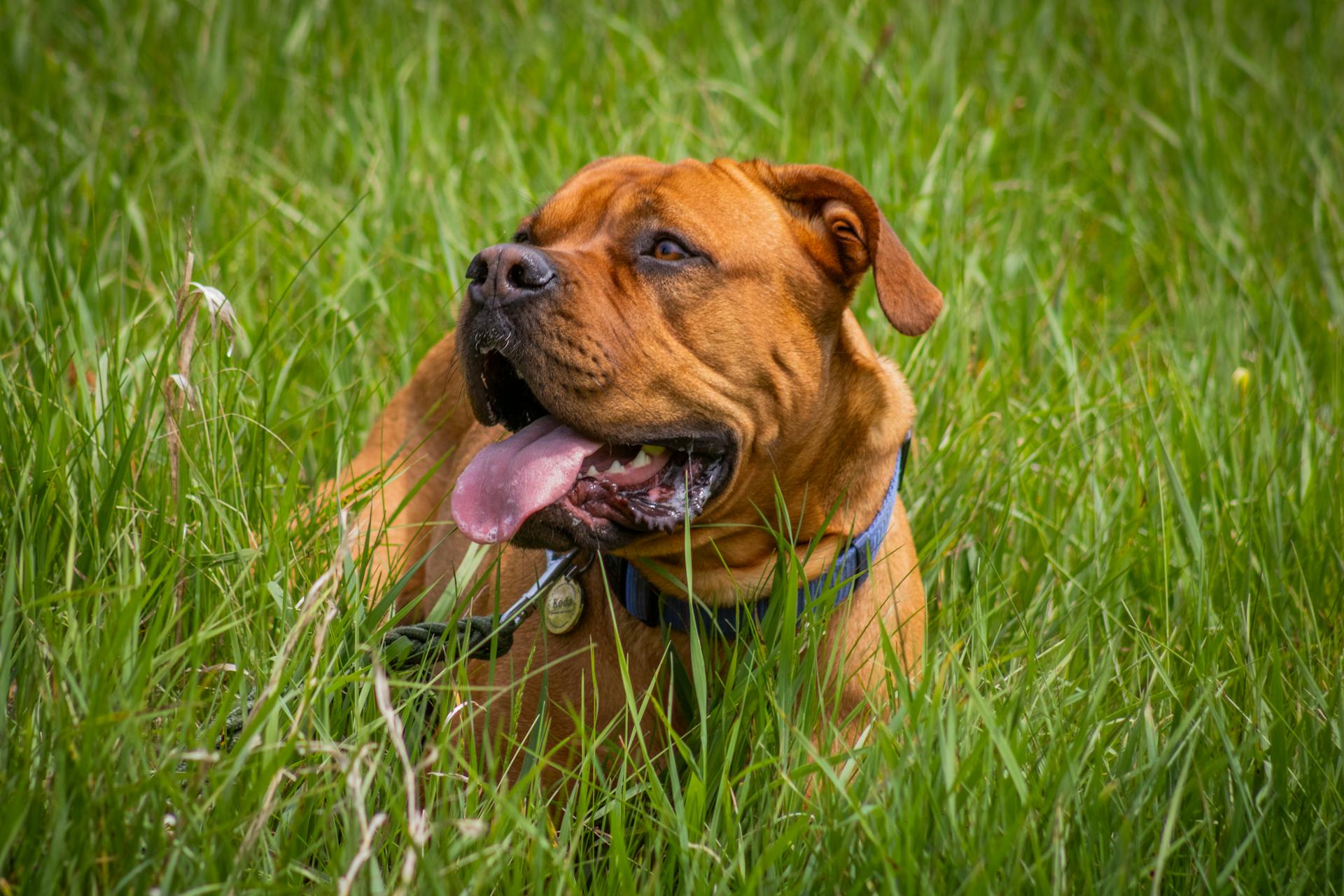
The American Mastiff and English Mastiff are two of the largest dog breeds in the world. The American Mastiff is a relatively new breed, developed in the 1990s.
One of the main differences between the two breeds is their size. The English Mastiff can weigh up to 230 pounds, while the American Mastiff typically weighs between 130-230 pounds.
Despite their size, both breeds are known for their gentle and calm nature. The English Mastiff is often described as a laid-back and easy-going companion, while the American Mastiff is known for its loyalty and affection towards its family.
Recommended read: Italian Mastiff Cane Corso Size
Temperament & Intelligence
The American Mastiff and English Mastiff are two breeds that share some similarities, but their temperaments are quite distinct. The American Mastiff is known for its calm and composed demeanor, making it an excellent companion for households seeking a peaceful pet.
Early socialization is crucial for American Mastiffs to cultivate their temperament properly, ensuring they grow into well-rounded companions. This breed is fiercely loyal and protective of their family, but their calm and composed demeanor never fades.
The English Mastiff, on the other hand, has a more stoic character that belies their patience, affection, and gentleness. However, they can be wary and slightly aggressive with strangers, making socialization essential.
Here are some key characteristics of the American Mastiff's temperament:
- Calm and Composed: The American Mastiff is known for its calm, composed demeanor.
- Loyal and Protective: These dogs are fiercely loyal to their families and will go to great lengths to protect them.
- Gentle Yet Strong: Despite their muscular build and strength, they are incredibly gentle creatures.
- Non-Aggressive: The American Mastiff is not an aggressive breed by nature.
In contrast, the English Mastiff is gentle and good-natured overall, but can be wary of strangers and requires proper socialization. They are also powerful animals that require a firm hand and proper obedience training to maintain order in the household and public settings.
Getting Along with Other Pets
Socialization is key to a harmonious household when it comes to American Mastiffs and other pets. If you start socialization early, your puppy will be more receptive to new pets.
Proper socialization can make a huge difference in how well an American Mastiff gets along with other pets. This process is most effective when done from a young age.
American Mastiffs are generally good with children and other pets if socialized properly from a young age. This makes them a great fit for families with multiple pets.
If you adopt an adult American Mastiff, it's best to talk to the adoption organization about their past experiences with other pets. This will help you determine if it's safe to introduce new pets to your household.
Owning a Large Breed Dog
Regular check-ups and a balanced diet are vital to ensure the health of a large breed dog like the American Mastiff, as they are prone to health issues such as hip and elbow dysplasia, heart conditions, and bloating.
American Mastiffs are highly compatible with families due to their protective but gentle nature, making them a great addition to households with children and other pets.
Their majestic size and distinctive temperament make them a unique addition to any family, but potential owners need to understand the specific care and attention they require, particularly regarding physical activity and mental stimulation.
Proper training and socialization from a young age play a crucial role in molding the temperament and behavior of an American Mastiff, requiring patience and consistency.
American Mastiffs are intelligent, but due to their stubbornness, they might initially resist obedience training, making it essential to approach training with a gentle but firm hand.
Here's an interesting read: What Is a English Mastiff
Health and Care
The American Mastiff and English Mastiff breeds share some similarities, but they also have some key differences. American Mastiffs were developed to have a reduced risk of health conditions, but they're not immune to them.
Some potential health issues to watch out for in American Mastiffs include hip and elbow dysplasia, Von Willebrand's disease, eye conditions, heart conditions, cancer, and epilepsy. These conditions can range from mild to severe.
Here are some specific health conditions to be aware of in American Mastiffs:
- Dysplasia: Both hip and elbow dysplasia are common among American Mastiffs due to their large size.
- Hyperthyroidism: American Mastiffs are prone to this disease, which develops when the thyroid gland doesn't function properly.
- Eye Problems: There are several types of eye problems that this breed can develop, including corneal damage, glaucoma, and cataracts.
- Forelimb Lameness: This type of health condition may develop due to soft tissue or bone injury.
Regular monitoring of their health is vital, and a balanced diet and daily exercise are equally important to keep your American Mastiff in the best possible health.
See what others are reading: English Mastiff Health Issues
Care: Essential Tips
American Mastiffs are massive dogs that require careful care and attention. They are prone to certain health conditions, so regular monitoring is crucial.
Dysplasia, which affects the hip and elbow joints, is a common issue in American Mastiffs. This condition can be painful and may require surgery.

A balanced diet is essential for maintaining your American Mastiff's health. They should be fed a high-quality dog food that meets their nutritional needs.
Daily exercise is also vital, but it's essential to avoid intense activities that can put stress on their limbs. A moderate walk or playtime in a secure area is perfect.
Here are some common health issues to watch out for in American Mastiffs:
- Dysplasia (hip and elbow)
- Hyperthyroidism
- Eye problems (corneal damage, glaucoma, cataracts)
- Forelimb lameness
- Mild allergies
- Heart conditions
- Cancer
- Epilepsy
By being aware of these potential health issues and taking proactive steps, you can help ensure your American Mastiff lives a happy and healthy life.
Life Expectancy
The life expectancy of an American Mastiff is around 8 to 12 years, which is relatively short compared to smaller breeds, but still impressive considering their robust size.
Finding a reputable breeder who prioritizes sound health over other factors is crucial to ensuring your American Mastiff lives a long and healthy life.
American Mastiffs are known for their impressive strength, but this shouldn't compromise their health, and a credible breeder will focus on breeding the healthiest pups.
Proper health management, diet, and overall care can significantly impact an American Mastiff's life expectancy, which can vary from 10-12 years on average.
Nutrition and Exercise

American Mastiffs and English Mastiffs have distinct exercise needs. Adult American Mastiffs typically require around one hour of exercise per day, which can be broken down into short walks and play sessions.
As puppies, it's essential to limit their exercise to prevent bone and joint damage. This means sticking to short walks and playtime rather than intense activities like agility training or jogging.
Feeding your American Mastiff is a significant responsibility, with adult dogs needing to eat more than four cups of food per day. It's best to follow the guidelines on the packaging of your chosen food formula or consult with your vet for the most accurate information.
Discover more: English Mastiff Food
Food & Diet
Your big dog needs a lot of food, especially if it's an American Mastiff. Adult dogs of their size typically need to eat more than four cups of food per day.
To ensure your dog gets the right nutrients, purchase a commercial recipe from a reputable brand. This formula should be balanced and complete, containing all the necessary nutrients like proteins, carbohydrates, fats, minerals, and vitamins.
A balanced diet is crucial for your dog's overall health. You should also provide clean water at all times to keep your dog hydrated.
Exercise

Exercise is a crucial part of a Mastiff's daily routine, but it's essential to keep it in check, especially for puppies. Adult American Mastiffs need around one hour of exercise per day.
Their large size and rapid bone growth require gentle exercise, so short walks and play sessions are best. This can be supplemented with training exercises to keep them engaged and active.
It's best to stick to short walks and play sessions rather than intense activities like agility training or going for a jog. This will help reduce the risk of bone and joint damage while they're in the critical development stage.
Walking your Mastiff a few times per day is a great way to keep them exercised and happy.
For your interest: Training English Mastiff Puppies
Training and Socialization
Training an American Mastiff requires an understanding of their unique background and traits, as they were bred originally as guard dogs protecting territory and livestock.
Firm but compassionate training is crucial to ensure they become well-rounded family dogs, favoring rewards-based methods over punishment.
See what others are reading: Difference between Male and Female German Shepherds
American Mastiffs respond well to consistent, positive reinforcement training methods, making them relatively easy to train.
Socializing an American Mastiff is equally important, and enhances their ability to get along with other dogs and people, especially around strangers.
Early and continuous exposure to various environments, smells, sounds, and experiences is encouraged, building confidence and discouraging instinctual reactions based on fear or anxiety.
English Mastiffs, on the other hand, are highly intelligent and sensitive dogs that can be slightly difficult to train, especially if you yell or get mad at your dog.
Training should be done in a quiet place with few distractions to optimize effectiveness, and consistency is key to establishing proper training practices.
American Mastiffs benefit significantly from early socialization, which is just as important as training, and helps them integrate seamlessly into their adopted families.
Due to their massive size, it's best not to indulge in agility training, as it can put too much pressure on their joints.
For your interest: Big Dogs English Mastiff
Choosing the Right Mastiff
Choosing the right Mastiff breeder is crucial to ensure the health and well-being of your new pet. American Mastiff breeders should prioritize ethical breeding practices and provide clear lineage and rigorous health checks for their puppies.
Both American and English Mastiffs need a lot of space to live, so make sure you have a big enough home to accommodate one of these gentle giants. They also get along swimmingly with kids and make excellent watchdogs and protectors.
To find a reputable breeder, research their history and check for any red flags. Look for breeders who are transparent about their breeding practices and prioritize the health and well-being of their dogs.
Here are some key characteristics to look for in a Mastiff breeder:
- Clear and traceable lineage
- Rigorous health checks
- Transparency about breeding practices
- Prioritization of dog health and well-being
Choosing the Right Option
Choosing the right Mastiff breed for you is a crucial decision, and it's essential to consider their size and space requirements. American and English Mastiffs are gigantic dogs that need a big space to live.
Both breeds are excellent watchdogs and protectors, but they also have a territorial and aggressive nature that needs to be addressed through proper socialization. This is critical to reducing their aggression and making them wonderful pets.
American Mastiffs drool much less than English Mastiffs, which is a significant consideration for some owners. Unfortunately, both breeds have a short lifespan, with most not making it past 10 years old.
To ensure you're getting a healthy puppy, look for breeders who provide a clear and traceable lineage for their mastiff puppies, along with performing rigorous health checks. This will contribute to preserving the integrity and quality of the breed for generations to come.
Here's a comparison of the two breeds:
Keep in mind that while both breeds make excellent pets, they do require a significant amount of care and attention. With the right owner, they can be loyal and loving companions, but it's essential to be aware of their needs and limitations.
English
The English Mastiff is a gentle giant, known to bark very little, which is normal for giant breeds. They're not likely to suffer from separation anxiety, but they do have a tendency to drool quite a bit.
If you're not a fan of slobber, the American Mastiff might be a better choice for you. However, if you're looking for a breed that's affectionate and gentle, the English Mastiff is an excellent option.
The English Mastiff has a rich history, but what's most important to consider is their temperament. They're known to be affectionate towards family members, making them a great addition to families with children.
Suggestion: Giant Poodle vs Standard Poodle
American
The American Mastiff is a breed that's often confused with its English counterpart, but they have some key differences. One notable difference is that American Mastiffs drool much less than English Mastiffs.
These dogs are known for their gentle and affectionate nature, especially if they're well-socialized from an early age. This is critical in reducing their territorial and aggressive tendencies. In fact, with proper socialization, American Mastiffs can make wonderful pets and loyal companions.
One of the most significant advantages of the American Mastiff is their relatively low maintenance when it comes to drooling. This makes them a great choice for people who don't want to deal with excessive slobber.
American Mastiffs are also known for their massive physical stature, which is an asset in warding off trespassers. They're a large breed that's been developed specifically to minimize health problems.
Here are some key facts about the American Mastiff breed:
- Recognized by the Continental Kennel Club since 2000
- Developed to retain protective capabilities without compromising gentleness
- Bred to minimize health problems and maintain fitness
- Known for their massive physical stature and relatively low maintenance drooling
Despite their intimidating appearance, American Mastiffs are known for their affectionate demeanor, especially towards family members. This makes them a great choice for families with kids, as they get along swimmingly with children.
Overall, the American Mastiff is a unique breed that offers a perfect balance of strength and gentleness.
Frequently Asked Questions
What two breeds make an American Mastiff?
The American Mastiff is a cross between Anatolian Mastiffs and English Mastiffs. This unique breeding combination aims to create a healthier mastiff with a similar appearance to other mastiff breeds.
What is the difference between an English Mastiff and a Mastiff?
The American Mastiff is a breed bred to have a similar body type and temperament as the English Mastiff, but with a genetic predisposition to fewer health issues. This makes the American Mastiff a distinct breed from the English Mastiff in terms of health and potential longevity.
Featured Images: pexels.com


